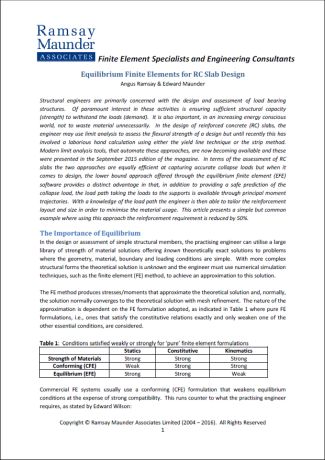Equilibrium Finite Elements for RC Design
Authors
Angus Ramsay
Edward Maunder
Abstract
Structural engineers are primarily concerned with the design and assessment of load bearing structures. Of paramount interest in these activities is ensuring sufficient structural capacity (strength) to withstand the loads (demand). It is also important, in an increasing energy conscious world, not to waste material unnecessarily. In the design of reinforced concrete (RC) slabs, the engineer may use limit analysis to assess the flexural strength of a design but until recently this has involved a laborious hand calculation using either the yield line technique or the strip method. Modern limit analysis tools, that automate these approaches, are now becoming available and these were presented in the September 2015 edition of the magazine (Modern limit analysis tools for reinforced concrete slabs, Ramsay, Maunder & Gilbert). In terms of the assessment of RC slabs the two approaches are equally efficient at capturing accurate collapse loads but when it comes to design, the lower bound approach offered through the equilibrium finite element (EFE) software provides a distinct advantage in that, in addition to providing a safe prediction of the collapse load, the load path taking the loads to the supports is available through principal moment trajectories. With a knowledge of the load path the engineer is then able to tailor the reinforcement layout and size in order to minimise the material usage. This article presents a simple but common example where using this approach the reinforcement requirement is reduced by 50%.






